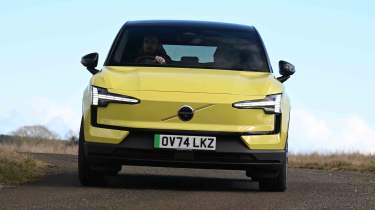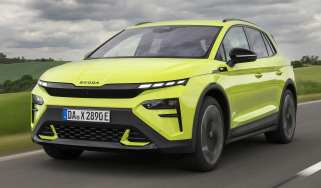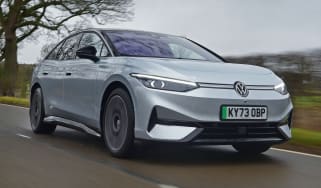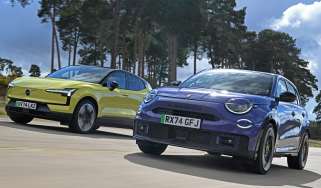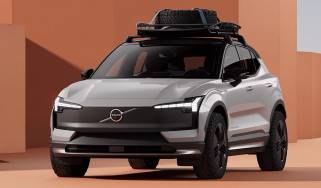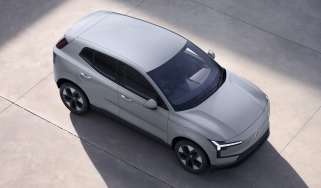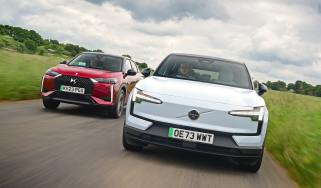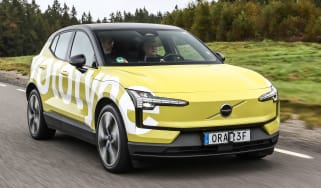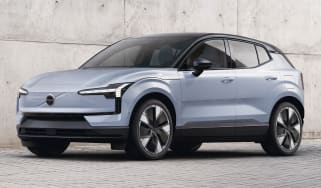Volvo EX30 review
Swedish brand’s smallest Volvo EX30 SUV delivers plenty of upmarket EV appeal

Our opinion on the Volvo EX30
The Volvo EX30 has impressed us on numerous occasions. It’s a very effective small EV that is good to drive, has a minimalist interior that feels special, features plenty of standard safety features and equipment, delivers eye-opening performance coupled with a competitive electric driving range, and yet manages this all at a reasonable asking price. The Performance model is good enough to drive that it could make for an intriguing alternative to a hot hatch for those who prefer to fly under the radar. The only real issues we have with it are the relatively tight rear space and ergonomic question marks surrounding the touchscreen.
| Key specs | |
| Fuel type | Electric |
| Body style | Five-door small SUV |
| Powertrain | 51kWh battery, 1x e-motor (Single Motor) rear-wheel drive 69kWh battery, 1x e-motor (Single Motor Extended Range) rear-wheel drive 69kWh battery, 2x e-motor (Twin Motor Performance) four-wheel drive |
| Safety | 5-stars (Euro NCAP, 2024) |
| Warranty | 3yrs/60,000 miles |
About the Volvo EX30
The Volvo EX30 is the smallest car that the Swedish company makes, but it brings over so much from larger, more luxurious models that it outclasses almost all other vehicles of its type and price when it comes to luxury and quality.
There are three versions to choose from, including the base Single Motor model that starts the range at around £33,000, putting the EX30 on a par with top-spec variants of cars such as the Vauxhall Mokka Electric, Abarth 600 (along with its Fiat 600 cousin), and Jeep Avenger. The EX30 Extended Range starts at around £37,500, and this basically adds a larger battery to the standard car. At the top of the range, the Twin Motor Performance has four-wheel drive and more power than the other two versions.
The best value is the Single Motor Extended Range, which has a 69kWh battery that offers more miles between top-ups than many of its rivals at the same price point; it even comes with an energy-efficient heat pump that helps improve range and charging in cold weather.
While the 4WD model seems suited to the EX30’s SUV shape, it isn’t really designed for off-roading, so the extra driven axle is for performance gains rather than traction on rough surfaces. We’d stick with the single-motor model, because it’s faster than anyone could surely need from a family car like this.
Trim levels comprise Core, Plus and Ultra, although the Core spec isn’t offered with the Twin Motor set-up. All models are generously equipped for the price.
If you're interested in getting yourself a Volvo EX30, we can help. Configure your ideal Volvo EX30 now to get top offers from local dealers, check out the latest Volvo EX30 leasing deals or search for used Volvo EX30 models with our Find A Car service. You can even sell your existing car for a great price with Auto Express Sell My Car.
Electric motors, performance & drive
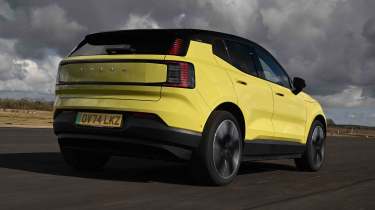
| Pros | Cons |
|
|
The Volvo EX30 offers strong performance and a well judged chassis. It isn’t truly exciting to drive, but it’s above average in this class.
As with most modern EVs, you can adjust how much regenerative braking you get when you lift off the throttle, as well as how heavy the steering is. But unlike most cars, the Volvo hides these features in a sub-menu on the main screen, rather than having them available at the touch of a physical button.
Electric motors, 0-60mph acceleration and top speed
The most powerful Volvo EX30, the Twin Motor Performance Ultra, takes just 3.6 seconds to accelerate from 0-62mph, which is the same time as a Porsche 911 Carrera 4S or even a Ferrari Enzo. The better-value Single Motor Extended Range model isn’t supercar-fast but still manages the sprint in 5.3 seconds, and the standard EX30 manages it in 5.7 seconds, but even these times are faster than you’ll ever likely need.
Since 2020, all new Volvos have been electronically limited to 112mph. In our experience on the test track, the limiter is fairly soft, so power tails off smoothly rather than shutting down suddenly when you reach it.
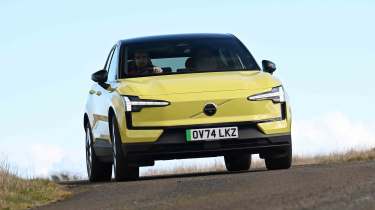
Town driving, visibility and parking
The Volvo’s punchy electric powertrain provides strong performance off the line and from low speeds, so you’ll never want for more power around town. The Swedish EV also deals with potholes and bumps pretty well, although the large 19-inch alloy wheels and heavy kerbweight are most apparent in city driving.
The EX30’s solution to this is its super-comfortable seats, because not only are they supportive, they are also soft enough to take the edge off of any bumps you can feel through the seat of your pants.
B-road driving and handling
Even though single-motor versions of the EX30 are rear-wheel drive, they don’t feel very sporty on twisty B-roads. Accelerate hard out of a corner, and you can feel the power shifting between the wheels automatically to maintain traction. It’s not as predictable as you would expect if you’re used to rear-wheel-drive petrol cars, because it relies heavily on traction control at each wheel. There’s not really any scope to play with the throttle during cornering, and it’s clear that the EX30 has been designed with commuting and efficiency in mind rather than sporty, rear-driven dynamics.
The EX30 rides on slightly firm suspension, but it’s very well judged, providing good body control without being uncomfortable. The steering and pedals feel numb, but that’s true of virtually any car in this class, although the Abarth 600e’s set-up feels more responsive. You can change the weight of the steering in the Volvo’s settings menu, but it doesn’t make a huge difference to how it feels.
A fairly firm squeeze of the brake pedal is needed to deliver a strong braking force, partly because there’s not much feedback through the pedal and partly because the car’s weight means it takes more effort to stop than many similarly sized petrol or diesel cars.
Motorway driving and long-distance comfort
Comfortable seats, smooth suspension and low road and wind noise mean the Volvo EX30 is a great car for motorway driving. It’s relaxing and has all the performance you need to overtake quickly when needed.
| Model | Power | 0-62mph | Top speed |
| Volvo EX30 Single Motor Core | 268bhp | 5.7 seconds | 112 mph |
| Volvo EX30 Single Motor Plus Extended Range | 268bhp | 5.3 seconds | 112mph |
| Volvo EX30 Twin Motor Performance | 422bhp | 3.6 seconds | 112mph |
“The brake pedal feels numb at the top of its travel and grabs a little too quickly at the bottom. If you need to make a quick stop, it can feel a bit disconcerting because the car doesn’t slow quickly enough to start with, then slows too sharply.” Alex Ingram, chief reviewer
Range, charging & running costs

| Pros | Cons |
|
|
The Volvo EX30 comes with two battery sizes, 51kWh and 69kWh, while the useable capacities are 49kWh and 64kWh, respectively. The larger battery comes with a heat pump as standard, whether you choose the Single Motor or Twin Motor version, and this is a more efficient way of heating the interior in colder weather without using as much of the main battery’s charge, and also helps to maintain driving range. It can also automatically preheat the pack when you select a charging station as a destination, too, which allows maximum top-up speeds earlier in the charging process.
Electric range, battery life and charge time
The standard battery option provides up to 214 miles of range, but the Extended Range car increases that to 296 miles. We averaged 3.5 miles/kWh on test from this version, which translates to 224 miles of real-world range. The Twin Motor four-wheel model saps a little range due to the weight penalty of the second electric motor up front, and because of the extra performance on offer, so there’s an official range of 280 miles.
Some rivals drive further, but the EX30’s charging speeds are impressive. The entry-level model tops out at 134kW, which means a 10-80 per cent charge takes around half an hour. This goes up to a 153kW rate in the Extended Range version, which allows a 10-80 per cent top-up in less than 30 minutes.
Most owners will probably use a 7.4kWh home wallbox charger to top up their EX30, and utilise cheaper overnight electricity rates - if they have the right electricity tariff. This means refilling the 51kWh battery should take less than 10 hours, while the 69kWh model has a sub-12 hour time.
| Model | Battery size (useable) | Range | Insurance group |
| Volvo EX30 Single Motor | 51kWh (49kWh) | 214 miles | 35E |
| Volvo EX30 Single Motor Extended Range | 69kWh (64kWh) | 296 miles | 37E |
| Volvo EX30 Twin Motor Performance | 69kWh (64kWh) | 280 miless | 40E |
Insurance groups
All versions of the EX30 sit in at least group 35, and the more powerful models go up to group 40. That’s higher than many other electric SUVs, but when you consider that the Volvo is faster than many petrol cars in the maximum group 50, it isn’t so bad.
Tax
Road tax is the same as for all other zero-emission EVs, at £195, while the standard low Benefit-in-Kind (BiK) rate for electric cars means that the EX30 is great for company-car drivers, especially when you consider the Volvo’s competitive P11D costs. Twin Motor and high-spec versions of the Extended Range model pass the £40,000 mark, so they are subject to the luxury car road tax surcharge.
Depreciation
According to our expert data, the EX30 is expected to retain between 48 and 54 per cent of its original value after three years or 36,000 miles – that’s slightly better than average for the class.
To get an accurate valuation of a specific model, check out our free car valuation tool...
Design, interior & technology

| Pros | Cons |
|
|
The EX30 looks familiar to the brand's other SUVs, thanks in no small part to details such as the ‘Thor’s’ hammer LED headlights and high-mounted tail-lights. It’s chunky and substantial at first glance, even if, in reality, it is actually shorter than a Volkswagen Golf.
There are five exterior colours to choose from, and thankfully, all of them are free. You can also pick between four interior colours, although your options might be limited by the trim you choose. Pine is exclusive to Plus trim, and the top-of-the-range Ultra adds Breeze and Mist colour schemes into the mix.
The EX30’s cabin is close to being one of the best cars in its class, thanks to its luxurious tech-packed interior, but ultimately the ergonomics let the side down.

Interior and dashboard design
Interior materials include woven fabrics and recycled materials rather than the typical plastic and leather you’d find in similar models, which helps the Volvo feel upmarket. Another factor is the minimalist dash; while this looks smart initially, when you come to drive the car, it doesn’t seem worth it – it compromises usability too much.
Almost everything is controlled via the touchscreen and many things that you need to access regularly require too many touches to get to – put simply, it’s annoying. Even things such as the window switches are irritating, because you can’t quickly lower the rear windows – you need to press a second button and use the same switch as for the front.
Materials and build quality
The materials in the EX30 are excellent, and the build quality is great as well. We didn’t hear any rattles or movement in the trim while driving, and special mention has to go to the seats, which are very comfortable and have equally smart covers. There are a few cheaper-looking bits around the cabin, but the key places you’ll interact with daily are good.
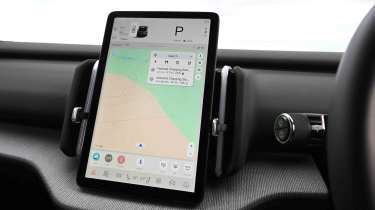
Infotainment, sat-nav and stereo
All models in the range have a 12.3-inch touchscreen, which controls virtually everything in the car. Volvo seems to have taken a leaf out of the Tesla book in this regard – even the speedometer and driving functions are on the main screen, because there’s no display behind the wheel at all. We’re not sold on it in the Tesla and it’s the same here, because you have to turn your head and look away from the road for longer than is comfortable to read your speed.
Putting aside the issues with usability, it’s a very good system that has all the features you could need. It’s easy to flick between functions, while the screen is responsive and loads up quickly enough. The Google-made interface looks more like a tablet PC than an in-car system, with lots of features, while the default Google Maps navigation is superb.
The screen is quick to respond to inputs and loads quickly. There were a few bugs that could be fixed in software updates, such as when charging at home, the readout was blocked by the “door open” notification.
All EX30 models get Apple CarPlay smartphone connectivity with wireless charging, but not Android Auto. The system uses Google software with four years' worth of unlimited mobile data to use with apps on the system and for in-vehicle communication.
A 1,040-watt Harman Kardon premium sound system is standard from Plus trim and above, featuring seven speakers in total, including a dashboard soundbar and a subwoofer in the boot. The entry-level Core trim uses a five-speaker set-up with 100-watts of output.
“It seems baffling that accessing simple tasks such as turning down the screen brightness or switching the rear window demister on would be so fiddly on the touchscreen display. Why Volvo, of all car manufacturers, would compromise safety for this distracting screen is rather confusing.” - Alex Ingram, chief reviewer
Boot space & practicality

| Pros | Cons |
|
|
Although the EX30 looks like a large SUV, it’s not all that spacious inside, so it will be mainly suitable for families with younger children.
Dimensions and size
The proportions are that of a compact SUV, but the EX30 is a small model that’s about the same length as a VW Golf. Cars with similar dimensions include the Jeep Avenger and Fiat/Abarth 600.
| Dimensions | |
| Length | 4,233mm |
| Width | 1,940mm (2,032mm inc. mirrors) |
| Height | 1,555mm |
| Number of seats | 5 |
| Boot space | 318-904 litres, plus 19 litres front boot |
Driving position, seats & space in the front
The front seats are supportive, soft and very comfortable to sit in for a long trip. There’s lots of head and shoulder room, plus there’s enough adjustment in the base, back and steering wheel for all sorts of drivers to get comfortable, even taller ones.
Storage up front is pretty good, because there’s a centre console cubby and a hidden section underneath where you can plug your phone into the USB ports unseen. A central section pops out with cup-holders, or you can remove the frame and use it as extra storage as well. Because it slides away, you can access the lower section more easily when needed.
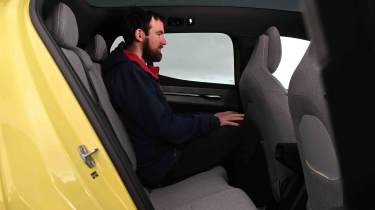
Seats & space in the back
Adults and teenagers will find that the high floor and limited legroom mean the rear seats feel rather cramped. Headroom is okay, but the tallest passengers might still brush against the headlining. With the front seats in an average position, there’s also not all that much room for your feet, so the rear feels as though it was designed for kids only. Access is fine, and it feels quite light in the back, which is unusual for a compact SUV.
Two ISOFIX child seat mounting points are provided on the rear bench's outer positions.
Boot space
While the boot size looks fairly normal for a crossover, at 318 litres, it’s one of the smaller storage spaces in its class. There’s also a compact 19-litre area under the bonnet, which is useful for charging cables. The 60:40 split-folding rear seat increases the load area to 904 litres, which is still small even for a compact SUV. A Hyundai Kona Electric provides 466 litres of space with the rear seats up, for example, and 1,300 litres with them folded. Even the sporty Abarth 600e has quite a bit more volume in either configuration.
Towing
The Single Motor model has a 1,000kg braked trailer towing capacity, while the Extended Range versions can pull up to 1,600kg, which is rather good for this size of electric car, and puts it above even the likes of the larger Skoda Enyaq and Volkswagen ID.4.
If you’re going to tow a large trailer or caravan, we would suggest you take a look at your mirror set up. As with the Polestar 2, the EX30 has frameless door mirrors, which will make it difficult to attach extension mirrors – you may need to invest in an alternative solution.
“The EX30 sits in compact car territory that the brand hasn’t explored since the three-door C30 hatchback almost two decades ago. The EX30 is almost identical in length to that model, but as fashion dictates, it takes the more practical shape of a five-door small SUV.” - Alex Ingram, chief reviewer
Safety & reliability
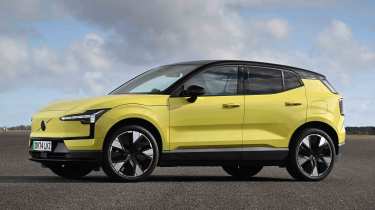
| Pros | Cons |
|
|
The EX30 didn’t appear in our 2024 Driver Power owner satisfaction survey, but Volvo finished 16th out of 32 brands. Safety, interior quality and front-seat comfort were among the highlights, but powertrains, running costs, and value for money weren’t. Still, the EX30 solves many of these issues, given its electric powertrain and decent price tag.
Safety expert Euro NCAP has awarded the EX30 the same five-star maximum rating as its sibling, the Smart #1. The EX30 scored higher than its other electric rival, the MINI Countryman Electric, in the adult occupancy and safety assistance categories, but the MINI was ahead in protection of children and vulnerable road users.
The Volvo EX30 comes with many standard safety features. For motorways and dual-carriageways, you have adaptive cruise control to keep you a safe distance from the car in front, a lane-keep assistance system to help keep you within your lane, and a blind-spot monitoring system to warn you of any vehicles alongside you as you go to change lanes. Around town, you have an autonomous emergency braking system to either mitigate or prevent low-speed collisions with other vehicles or vulnerable road users, such as pedestrians or cyclists. There’s also a road sign warning system that will, amongst other things, warn you of the current speed limit.
| Key standard safety features | Euro NCAP ratings |
|
Buying and owning
- Best buy: Volvo EX30 Single Motor Extended Range Plus
The mid-range trim with the rear-drive configuration and larger battery offers the best value and the longest range from a charge. It’s more than fast enough, too.
The EX30 comes with Volvo’s standard three-year, 60,000-mile warranty, and the battery gets eight years or 100,000 miles of cover. This is the same as pretty much all the major manufacturers in the UK, although some makers, such as Toyota, MG, Kia, Hyundai and some newer Chinese brands, offer longer terms.
Fixed-price servicing is available from Volvo dealers, although because it’s a premium brand, it tends to be a little more expensive than for rival car makers such as Fiat with its 600e.

Volvo EX30 alternatives
The Volvo EX30 is an appealing small electric SUV for those who need a smart-looking, premium small car that’s zippy enough to nip into traffic in the city, yet still has the range and swift charging speeds that make the occasional long trip a possibility. There are rivals on all fronts, such as the Hyundai Kona Electric, DS 3 E-Tense, Jeep Avenger, Kia Niro EV and Peugeot E-2008, as well as similarly priced electric hatchbacks, including the Cupra Born, Renault Megane E-Tech and Volkswagen ID.3, to name but a few.
Deals on the Volvo EX30 and alternatives
Volvo EX30 pictures
Frequently Asked Questions
On the whole, yes, it’s a decent option in the sector. You’re getting a small electric SUV with a premium badge for the price of a high-spec model from a mainstream manufacturer, and it has plenty of neat design touches. If you don’t need masses of space, then it could be a good choice.




